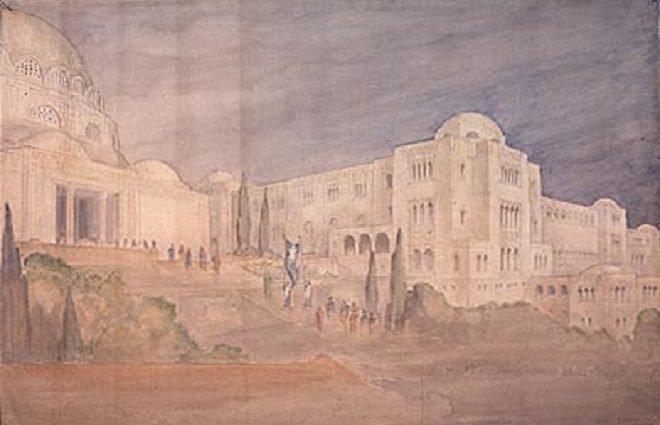The Planning and Building of the Hebrew University, 1919-1948: Facing the Temple Mount
Graeme Purves treats us to a full review of this exciting new publication
Diana Dolev
Lexington Books (2016)
ISBN-10: 0739191616
£49.24
Diana Dolev teaches architecture at the Holon Institute of Technology in Israel and researches the relationship between national identity and architecture. In this book she provides the first comprehensive account of the successive schemes for the development of the Hebrew University of Jerusalem under the British Mandate in Palestine, from the masterplan prepared by Patrick Geddes and Frank Mears in 1919 to Richard Kauffmann’s campus plan of 1944.
Dolev takes as her starting point the site chosen for the development of the university on a ridge to the east of the historic city. Once the Gray Hill Residence on the summit of Mount Scopus was purchased for the future university, the view of the Islamic Dome of the Rock on the Temple Mount provided a powerful point of reference irresistible to its planners and architects.
The Hebrew University was a flagship project of the Zionist Organisation and was given prominence in its publicity and propaganda efforts across the world. It was never meant to be simply the University of Jerusalem. Its significance had nationalist and religious dimensions. In 1913 the Zionist Congress in Vienna made the decision that the university should be located in Jerusalem, thus recruiting it to the cause of the revival of ancient Hebrew identity in Eretz Israel. But the university project was also associated in Zionist rhetoric with the Holy Temple (or the biblical ‘Mount Zion’) and the idea of a Third Temple. Dolev makes the point that in the nineteenth and early twentieth century, the metaphoric image of a Third Temple had wide currency amongst Jews and Christians, religious and secular. It was not so much that they wished actually to construct it – rather it represented a general abstract idea of revival and hope for a better future. Furthermore:
“Associating the proposed university with the rebuilding of the Temple had an enormous impact on the university’s image. From then on the university and the Temple were merged in an equally abstract but dominant imaginary vision. Mount Scopus became the dedicated home of the Hebrew University, as if it was meant to stand there by divine decree.”
Dolev describes Jerusalem as “…a forlorn, poor and badly neglected little town” by the end of Ottoman rule and suggests that its inhabitants “…lived out their mundane lives, more or (probably) less aware of its divine and spiritual reputation”. However, Western visitors tended not to see Palestine as it was, but through the lens of the Bible. While British rule brought a new concern for the built environment, Dolev argues that the building regulations introduced by the first Military Governor, General Ronald Storrs, perpetuated and enhanced “…a stagnating Orientalist picture of Jerusalem”.
Patrick Geddes was engaged to prepare a scheme for the Hebrew University at the instigation of the psychiatrist, Dr. David Eder, who headed the Zionist Organisation’s London Branch. The Old Testament emphasis of Geddes’ Presbyterian upbringing made him receptive to the Zionist vision for the university. He also saw the project as a golden opportunity to put his ideas about universities into practice.
The involvement of Patrick Geddes in the early development of university is well established, but Dolev’s book gives prominence and welcome recognition to the role played by his son-in-law and assistant, Frank Mears, in translating Geddes’ ideas into plans and architectural drawings:
“Frank Mears’ contribution to Geddes’ Hebrew University plan eventually became highly significant. …though he was often overshadowed by Geddes and quite underestimated, he actually became enormously valuable for the project, and his training and capabilities contributed substantially to the attractiveness of Geddes’ plan.”
“While the theory behind the master-plan was all Geddes’s, it was Mears’s drawings that dressed Geddes’s abstract ideas with luxurious visual images and captured the imagination of all interested parties as well as the general public.”
Geddes was at pains to stress that his university scheme was intended to echo the architectural characteristics of the city of Jerusalem as well as local towns and Arab villages, but he also acknowledged that his decision to accept the appointment was inspired by a passage in Revelations (XXI-2) in which St. John says: “And I John saw the holy city, new Jerusalem, coming down from God out of heaven, prepared as a bride adorned for her husband.” As Dolev astutely points out, the visionary perspective he shared with his Zionist employers led him to promote a campus university detached from the city and its population, quite contrary to his evolutionary and holistic ideas. She also argues that the differences between the envisaged scheme and the historic city were fundamental:
“…while the Old City was formed of an unplanned hodge-podge of mostly dilapidated buildings built on top of each other, the Geddes plan and Mears’ drawings form not only an orderly building complex but also a set of magnificent palaces belonging to the realm of legend.”
Dolev sees Mears’ architectural drawings for the university buildings as reflecting an Orientalist perspective which dominated the European view of the Holy Land throughout the nineteenth and in the beginning of the twentieth century. She provides persuasive evidence that one of Mears’ perspective drawings of the university campus is derived directly from a print depicting the Tower of David by William Henry Bartlett published in Jerusalem Revisited in 1855.
Dolev devotes a full chapter to the Geddes and Mears masterplan of 1919, giving detailed attention to Geddes’ proposal for a Great Hall, or ‘Dome of Synthesis” as its focal point. This major building, designed to accommodate assemblies of up to 3,000 people, would face the Temple Mount and its hexagonal plan was intended to reflect sound principles of construction employed by bees, a six-faceted notation of Life, and the Star of David.
“Mears’s depiction of the Great Dome as a mirror image of the Dome of the Rock truly and effectively represented Geddes’s concept of the dome as a temple within the university. It gained enormous attention and popularity and became the best known feature of the future university – almost a sacred image in itself.”
A further chapter is devoted to a detailed account of the efforts of Mears, in collaboration with the Jerusalem-based architect Benjamin Chaikin, to come up with designs for specific university buildings which were acceptable to the various factions which wielded influence over the university project. Dolev sheds valuable light on the divisions and rivalries within the Zionist Organisation which repeatedly bedevilled progress towards its realisation. Three contesting university committees were established; in London, Paris and Jerusalem. One powerful faction, to which the Chancellor, Dr. Yehuda Leib Magnes, was closely aligned, saw Jewish Studies as the principal raison d’être for the university. Others gave priority to establishing scientific research institutes in and around the Gray Hill Residence. British and German Zionists battled each other for influence. The head of the World Zionist Organisation, Chaim Weizmann, saw the university as having a political role, while Magnes believed that it should be free of political involvement. Some favoured the Geddes and Mears designs while others believed that it would be inappropriate for non-Jews to design the Hebrew University.
Geddes and Mears were finally dismissed by the Zionists in 1929, and only three university buildings designed by Mears and Chaikin were built on Mount Scopus: the Einstein Institutes of Mathematics and Physics and the David Wolffsohn Library. The building on which the relationship between the university authorities and their architects finally foundered was the Jewish Studies Institute, which the Rosenblooms, a wealthy family from Pittsburg, Pennsylvania had undertaken to fund. Mears and Chaikin made repeated revisions in an attempt to meet the changing demands of the Rosenbloom Trustees. The funders were insistent that the Jewish Studies Institute should be accorded a central position on the university campus and eventually Geddes’ Great Hall was abandoned altogether in order to accommodate this desire.
It was all to no avail. In May 1929, Mears, Geddes and Chaikin were informed by the University Trustees that their services were no longer required in relation to the design of the Rosenbloom Memorial Building.
In my own research into the planning of the Hebrew University I suggest that the hostility to the idea of the Great Hall expressed by some Zionists stemmed from their suspicion of the symbolism Geddes attributed to it as a Dome of Synthesis, a place where Judaism, Christianity and Islam are linked together, a commitment toward the unity of the different religious communities in Palestine to which they could not subscribe. That view finds support in Mears’ correspondence and the comments of well-informed contemporary observers such as Charles Ashbee (though he had his own Arabist axe to grind). Dolev doesn’t see such considerations as decisive. In her perspective, the Geddes plan was primarily doomed because it bore little relationship to the university’s immediate practical needs and resources, but also because the appeal of its romantic Orientalist vision was rapidly fading in the face of Modernism.
The development of the university campus was halted abruptly by the 1948 Arab-Israeli war, which left Mount Scopus within the territory of Jordan. At that time, it was little more than a scatter of buildings in a mix of architectural styles, some of them unfinished. In the 1930s, the architect Erich Mendelsohn had described it bluntly as “…a wretched botched fruit of incompetence”. For Dolev, the power of the invented significance of the site for Israeli national identity was demonstrated by the precipitate return of the university to Mount Scopus after the 1967 war:
“Yet it did not matter: the image of the Mount Scopus campus in the eyes of the Jewish public in Israel was not dimmed as a result of the final architectural outcome. An ephemeral portrayal of God’s Temple combined with the national significance attributed to university and mount had more power than the general impression of unattractive buildings scattered around.”
This is an important and ground-breaking book. In pursuing the missing pieces in the story of the Hebrew University, Diana Dolev has opened a window which offers fascinating new perspectives on the influences upon and debates and narratives within Zionism during the period of the British Mandate in Palestine and how these shaped the development of its flagship project.
Graeme Purves
Graeme Purves is the Chairman of the Built Environment Forum Scotland, BEFS. Graeme retired from the post of Assistant Chief Planner in the Scottish Government’s Planning and Architecture Division in September 2013. Graeme has a B.Sc. in Botany from theUniversity of Aberdeen and a Diploma in Town and Country Planning from Heriot-Watt University. In 1988 he was awarded a Ph.D. for his research on the work of the pioneer Scottish planner, Sir Frank Mears. Graeme was appointed an Officer of the Order of the British Empire for his services to planning in the New Years Honours List for 2014. He is a member of the Scottish Advisory Committee of the Royal Society for the Protection of Birds.
BACK


